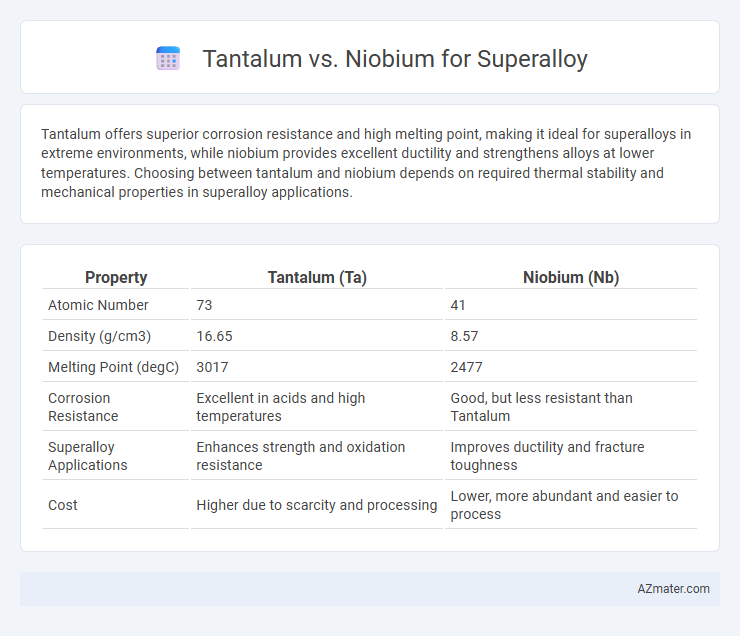Tantalum offers superior corrosion resistance and high melting point, making it ideal for superalloys in extreme environments, while niobium provides excellent ductility and strengthens alloys at lower temperatures. Choosing between tantalum and niobium depends on required thermal stability and mechanical properties in superalloy applications.
Table of Comparison
| Property | Tantalum (Ta) | Niobium (Nb) |
|---|---|---|
| Atomic Number | 73 | 41 |
| Density (g/cm3) | 16.65 | 8.57 |
| Melting Point (degC) | 3017 | 2477 |
| Corrosion Resistance | Excellent in acids and high temperatures | Good, but less resistant than Tantalum |
| Superalloy Applications | Enhances strength and oxidation resistance | Improves ductility and fracture toughness |
| Cost | Higher due to scarcity and processing | Lower, more abundant and easier to process |
Introduction to Tantalum and Niobium in Superalloys
Tantalum and niobium are critical refractory metals utilized in superalloys for their exceptional high-temperature strength and corrosion resistance. Tantalum enhances creep resistance and oxidation stability in superalloy matrices, while niobium contributes to phase stabilization and improves tensile strength at elevated temperatures. Their complementary properties optimize superalloy performance in aerospace, gas turbines, and nuclear reactors.
Elemental Properties: Tantalum vs Niobium
Tantalum and niobium exhibit close elemental properties critical for superalloy applications, with tantalum offering a higher melting point of 3017degC compared to niobium's 2477degC, enhancing thermal stability. Both elements share similar atomic numbers, 73 for tantalum and 41 for niobium, and atomic radii, contributing to their strong corrosion resistance and ductility. Tantalum's greater density (16.69 g/cm3) versus niobium's (8.57 g/cm3) influences weight-sensitive superalloy designs, favoring niobium where lower mass and high strength are required.
Mechanical Strength and Durability Comparison
Tantalum exhibits superior mechanical strength and high-temperature stability compared to niobium, making it ideal for enhancing superalloy durability in extreme environments. Niobium, while offering excellent toughness and corrosion resistance, generally possesses lower creep resistance under prolonged high-temperature stress. The choice between tantalum and niobium depends on balancing peak mechanical performance against cost and oxidation behavior in superalloy applications.
Corrosion and Oxidation Resistance
Tantalum exhibits superior corrosion resistance compared to niobium, especially in aggressive acidic environments, making it highly valuable for superalloys exposed to extreme chemical conditions. Niobium offers enhanced oxidation resistance at elevated temperatures, forming a stable oxide layer that protects superalloy components operating in high-heat applications. Combining tantalum and niobium in superalloy formulations leverages their complementary corrosion and oxidation resistance properties, optimizing performance in harsh, high-temperature environments.
High-Temperature Performance
Tantalum exhibits superior high-temperature strength and oxidation resistance compared to niobium, making it a critical element in superalloys used for extreme environments like jet engines and gas turbines. Niobium enhances superalloy ductility and creep resistance at moderately elevated temperatures but underperforms against tantalum in maintaining stability above 1200degC. The unique refractory properties of tantalum contribute to improved phase stability and corrosion resistance at temperatures where niobium alloys might degrade.
Alloying Behavior in Superalloy Systems
Tantalum exhibits superior high-temperature strength and oxidation resistance when alloyed in superalloy systems, contributing to enhanced creep resistance and phase stability. Niobium improves phase ductility and grain boundary strengthening but may reduce oxidation resistance compared to tantalum, affecting overall alloy longevity under extreme conditions. The selection between tantalum and niobium depends on balancing high-temperature mechanical properties with oxidation behavior in critical superalloy applications.
Cost and Resource Availability
Tantalum's high cost and limited global reserves make it less economically feasible for widespread superalloy applications compared to niobium, which benefits from more abundant resources and lower prices. Niobium's greater availability supports sustainable production, reducing supply risk in superalloy manufacturing. This cost-effectiveness and resource accessibility position niobium as a preferred choice for enhancing high-temperature strength and corrosion resistance in superalloys.
Typical Industrial Applications
Tantalum is primarily used in superalloys for aerospace components such as turbine blades and rocket engine parts due to its excellent high-temperature strength and corrosion resistance. Niobium, on the other hand, is favored in superalloys for jet engines and gas turbines because it enhances creep resistance and strengthens the alloy at elevated temperatures. Both elements improve the overall performance of superalloys in extreme industrial environments, but tantalum's superior chemical stability makes it more suitable for highly corrosive applications.
Environmental and Processing Considerations
Tantalum exhibits superior corrosion resistance and high melting point, making it ideal for superalloy applications in extreme environments, but its extraction involves significant environmental challenges due to rare ore deposits and energy-intensive processing. Niobium offers easier processing with lower melting points and lower environmental impact during extraction, contributing to reduced carbon footprints in superalloy manufacturing. Both metals require controlled recycling and sustainable mining practices to mitigate ecological damage and resource depletion in high-performance aerospace and industrial superalloys.
Conclusion: Choosing the Optimal Element for Superalloys
Tantalum offers superior high-temperature strength and corrosion resistance, making it ideal for superalloys used in extreme environments such as aerospace and turbine engines. Niobium provides excellent ductility and oxidation resistance at moderately high temperatures, which enhances alloy formability and toughness. Selecting between tantalum and niobium depends on application-specific requirements, with tantalum preferred for extreme thermal stability and niobium favored for improved mechanical properties and cost efficiency in less demanding conditions.

Infographic: Tantalum vs Niobium for Superalloy
 azmater.com
azmater.com